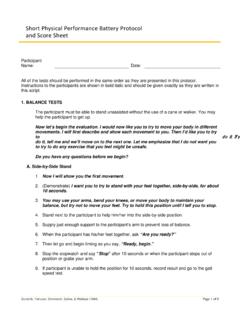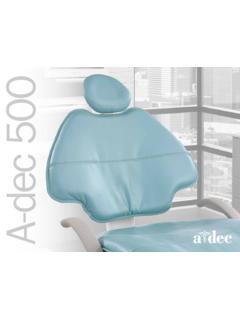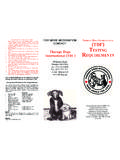Transcription of Utah Nursing Assistant State Certification Exam Guide
1 Utah Nursing Assistant State Certification Exam Guide 1st Edition January 2018 1 | P a g e UNAR State Certification Exam Guide Introduction The Nursing Assistant Certification process in the State of Utah requires that you demonstrate minimum competency by passing both a knowledge and skills demonstration exam upon completion of your Nursing Assistant training. You have 1 year from the date of completion from your training program to pass both portions of the exam. Students who test soon after completing have a significantly higher pass rate than those who wait more than 3 months. Skills The State of Utah requires that each student completing a Nursing Assistant course learn and demonstrate the ability to perform more than 70 skills.
2 This is documented while enrolled in a training program by completing the UNAR Nursing Assistant Skill Proficiency Performance List (NAPP). Of the 70+ skills learned, 22 have been identified for inclusion in the State skills exam and are included in this Guide . Of these 22, you will be expected to perform 5 random skills during the State test. To pass the skill exam you must receive a minimum score of 75% for each skill performed along with 100% of key steps and complete testing within 45 minutes. Knowledge The knowledge portion of the exam consists of 75 multiple-choice questions. In order to pass the knowledge test you must receive a minimum score of 75%. This means you must answer a minimum of 57 questions correctly to pass this portion of the exam. The exam questions are selected randomly by the testing software from a large pool of questions that have been approved by a UNAR Test Advisory Panel.
3 The panel consists of Nursing Assistant instructors from the State of Utah. Each question has been reviewed for accuracy and appropriateness by the panel. Testmaster Universe (TMU) TMU is the software program that is used by UNAR to provide Certification testing and maintain registry records. Upon completion of a training program or by means of reciprocity, each individual is assigned their own personal portal and username and password. You will need your username and password when you take your knowledge test. You will have access to this portal throughout your CNA career, using it to update your contact information and for information related to your Certification . Where to Test UNAR has testing site partners across the State in Blanding, Cedar City, Kaysville, Hurricane, Lehi, Logan, Moab, Ogden, Price, Richfield, Roosevelt, Salt Lake City, St.
4 George, Tooele and Vernal. Test Scheduling Each test site is run independently and sets their own schedule. To view the most current list of our testing sites, visit UNAR s website at and view the Test Site Information document. This document will also list each site s testing hours and whether an appointment is required for the knowledge exam or if they welcome walk-ins. Appointments are always required for the skill exam. This document can also be viewed in your TMU personal portal. To schedule a test with a specific test site you must login to your TMU personal portal and pay for the test. Testing fees are non-refundable. Once you have paid for your test, you will be able 2 | P a g e to access all the testing appointments that are available.
5 You can also reschedule any testing appointments through your TMU personal portal. If you schedule an appointment for your knowledge test and later decide you would like to test as a walk-in, you must first cancel your testing appointment. If you miss your scheduled appointment, you will lose your testing fee. ID Requirements A current, valid, photo ID must be presented at time of testing and must be the original ID. (Photo, fax, or digital copies will not be accepted.) Printed name on ID must match name of tester in TMU. ID must have an expiration date and must be current. The following forms of ID are acceptable: Driver's license, learner's permit, or temporary operator card from any State ID issued by any branch, department, or agency of the US or State of Utah High school, technical school, college, or professional school within the State of Utah (may not have expiration date but must be current school year) A tribal ID card Passport from any country What are you allowed to have with you during testing?
6 Personal items are to be stored according to test site policy. No cellphones are allowed. You may use a calculator, scratch paper and pencil/pen, all of which are provided by the testing site. A translation dictionary is allowed but must be provided to the testing center in advance for inspection and may not contain definitions or added notes. All equipment needed for the skills test will be provided by the testing site including blood pressure cuff, stethoscope and a watch. Dress for Skills Exam All examinees must wear scrubs, closed toe shoes, have their hair tied back and no dangling jewelry. Physical Limitations You will not be allowed to take the skills exam if you have an injury, serious illness or are more than 6 months pregnant without providing the testing site with a health care providers release to work full duty as a CNA.
7 Accommodations Accommodations for testing may be requested by completing the ADA Accommodations Request form available on UNAR s website, The completed form and supporting documentation should be submitted to UNAR as directed on the form. Three Testing Attempts Students completing a training course have up to 1 year to pass both the knowledge and skill exams and are given up to three attempts at both portions of the exam. Expired CNA s who meet the necessary criteria to test have only one attempt at both portions of the exam. Any changes or cancellations to a testing appointment must be made at least 1 full business day prior to your testing appointment. If you fail to show up to your scheduled appointment, you will forfeit your testing fee. 3 | P a g e MUST READ The skill steps in this Guide are to be used for objective testing purposes only at the State skills exam.
8 They are not to be used to help you learn how to properly perform skills. The steps listed for each skill are not intended to be used to provide complete care that would be considered all-inclusive of best care practiced in an actual care setting. When performing actual resident care, skill steps as detailed in your Nursing Assistant textbook and/or taught in your Nursing Assistant training program are to be used as the basis for care you provide residents. 1 - Handwashing Candidate is asked to wash hands with soap and water. 1 Wets hands thoroughly with warm water 2 Applies soap to hands 3* Washes hands for at least 20 seconds 4 Rubs hands together lathering all surfaces of hands/fingers 5 Lathers surfaces of wrists 6 Cleans fingernails by rubbing them in palm of other hand 7 Rinses hands/wrists with fingers pointing downward 8 Dries hands/wrists with clean paper towel 9 Turns off faucet with paper towel(s) 10* Does not touch clean hands to sink or faucet 11 Immediately discards paper towel into trash can without touching other hand 2 - Vital Sign: Blood Pressure Candidate is asked to take resident s manual blood pressure.
9 Candidate may use 1-step method or 2-step-pulse obliteration method (as preferred by candidate). A recording form is provided to document blood pressure reading. Resident is sitting at a table. A person portrays role of resident. 1 Greets resident by name 2 Introduces self by name and title 3 Performs hand hygiene 4 Explains procedure to resident 5 Cleans earpieces of stethoscope with alcohol wipe 6 Cleans diaphragm of stethoscope with alcohol wipe 7 Positions resident s arm in a resting position, on a firm surface with palm facing up 8 Wraps cuff properly around upper arm with bladder over artery 9 Places diaphragm over brachial artery 10 Inflates cuff to 160-180mm/Hg or uses 2-step obliteration method 11 Slowly deflates cuff, watching sphygmomanometer 12 Removes cuff from arm 13 Records blood pressure reading on recording form 14* Recorded systolic blood pressure is within +/-10 mm/Hg of observer s measurement 15* Recorded diastolic blood pressure is within +/-10 mm/Hg of observer s measurement 16 Places call light.
10 Water and phone within resident reach 17 Performs hand hygiene *INDICATES KEY STEPS IN EACH SKILL. 4 | P a g e 3 - Vital Sign: Pulse/Respirations Candidate is asked to take resident s pulse and respirations. Obtaining pulse and respirations are to be completed as two separate activities. Candidate may take radial or apical pulse (as preferred by candidate). Candidate may count pulse/respirations for 30 seconds then double number or count for one full minute (as preferred by candidate). A recording form is provided to document readings. Resident is sitting at a table. A person portrays role of resident. 1 Greets resident by name 2 Introduces self by name and title 3 Performs hand hygiene 4 Explains procedure to resident 5 Locates radial pulse on thumb side of wrist or uses apical method by placing diaphragm of stethoscope on left side of resident s chest 6 Counts pulse rate for 30 seconds then doubles number or counts for 1 full minute 7 Records pulse rate on recording form 8* Recorded pulse reading is within +/- 4 beats of observer s recorded reading 9 Counts respiratory rate for 30 seconds then doubles number or counts for 1 full minute 10 Records respiratory rate on recording form 11* Recorded respiratory reading is within +/- 2 breaths of observer s recorded reading 12 Places call light, water and phone within resident reach 13 Performs hand hygiene 4 Anti-Embolism Stocking (One Leg)









